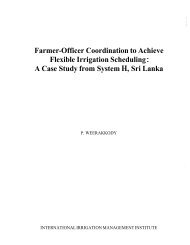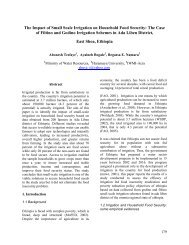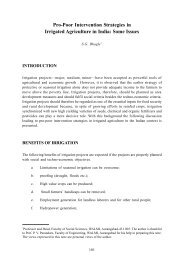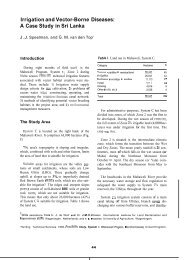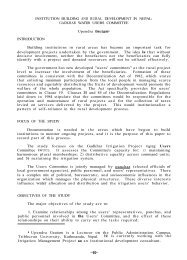WATER POVERTY IN THE NORTHEASTERN HILL REGION (INDIA)
WATER POVERTY IN THE NORTHEASTERN HILL REGION (INDIA)
WATER POVERTY IN THE NORTHEASTERN HILL REGION (INDIA)
Create successful ePaper yourself
Turn your PDF publications into a flip-book with our unique Google optimized e-Paper software.
<strong>WATER</strong> <strong>POVERTY</strong> <strong>IN</strong> <strong>THE</strong> NOR<strong>THE</strong>ASTERN <strong>HILL</strong> <strong>REGION</strong> (<strong>IN</strong>DIA): POTENTIAL ALLEVIATION THROUGH MULTIPLE-USE <strong>WATER</strong> SYSTEMSfallow for 7–9 years. The fallow period used to be 15–20 years but because of pressure of land andpopulation the average Jhum cycle in recent years has reduced to 8 and even 5 years in some areas.3.5.3. Cropping pattern in JhumsThe crops sown by the shifting (Jhum) cultivators of the region are based on tradition. Mixedcropping is the main cropping system. In mixed cropping system crops are sown in irregularfashion or random planting. There are no definite crop mixtures. Every cultivator follows his ownsystem of crop combination according to his family requirements. But, the majority of farmers inthe village grow rice as the main crop and along with it grow maize, millets and other vegetables(mainly Taro) as mixed crops. Here, Jhum farmers normally grow as many crops as possible, asdecided by the community.3.5.4. Economic yield pattern under JhumThough specific data could not be collected on the economic yield under shifting cultivation,production is used as a proxy for looking at it from the viewpoint of benefits generated. Since thepeople in the village do not have a measure of their land nor the production, the land ownershipand the area of land sown have been identified by pointing out to the school playground whichwas approximately 1 acre in area and using it as a reference point. Even the production has beenidentified by helping them recall number of baskets of grains they have carried home. Each basketweighs approximately 14 kg when filled with grains. The above methods are not foolproof andnecessary corrections have been made wherever applicable to make the data as close to actual valuesas possible.3.5.5. Animal husbandryAnimal husbandry in Lampong Sheanghah includes rearing mainly pigs and cattle. Forty-five percentof the households in the village are active in pig rearing. Pigs are generally kept in enclosuresconstructed near the house. They are fed with household waste, agricultural by-products and maizewhich are all boiled together and fed to the animals. Fully grown pigs are sold for anything betweenRs 8,000 and Rs 15,000. About 34% of the families in the village rear cattle. Cattle in the villageare reared mainly for meat and not for milk; even the cow dung is not used as manure. Cows andbuffaloes are allowed to graze in the forest during the day. They are not provided any feed from thehouseholds. Since the cattle are left unattended, there have been instances of them being stolen orkilled in accidents on the road.Most households (about 71%) also reared poultry. The birds are kept solely for the purpose of meat andnot for eggs. Since chicken is expensive in these parts, poultry is a good supplement to regular incomefor the households. Some of the households keep ducks instead of hen as they fetch a better price inthe market. ICAR- Regional Centre, Nagaland had distributed live chicken (Kuroiler breed) to a largenumber of households for rearing, but a majority of them died due to disease.20



